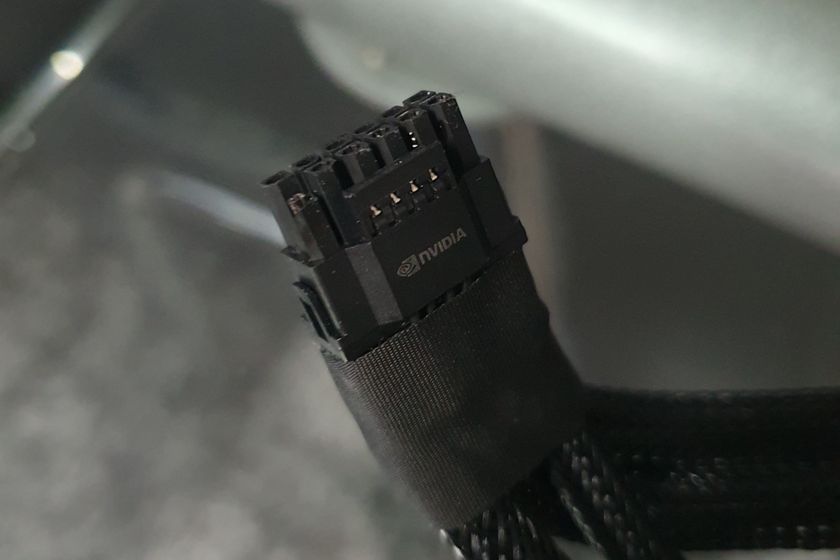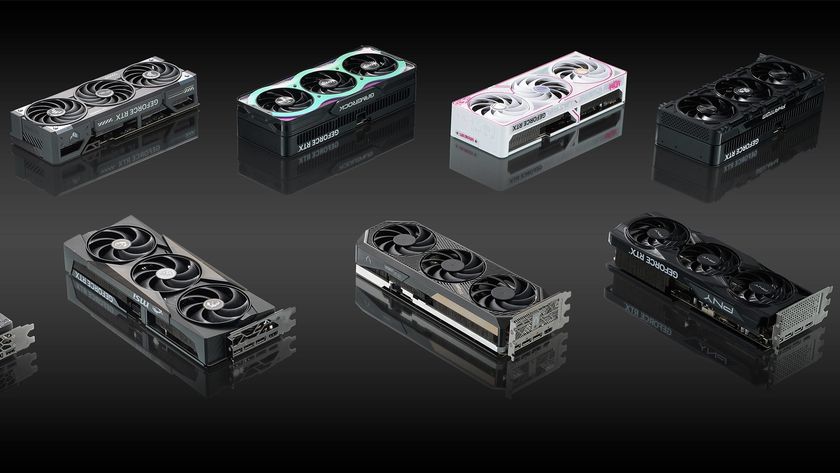Early Verdict
Gigabyte's Radeon RX Vega 56 Gaming OC 8G began life as an Aorus-branded stunner, but had to be pared back in the face of supply issues from AMD. What remains is still a very fast gaming board, albeit with a more budget-oriented cooler. Unfortunately, limited availability means there aren't many to go around.
Pros
- +
Noise-optimized design
- +
Well-implemented heat pipe direct touch cooler
- +
Great 2560x1440 gaming performance
- +
Six display outputs
Cons
- -
Poor availability
- -
Uncertain pricing
- -
Fan speed slightly too low
- -
No thermal headroom for overclocking
Why you can trust Tom's Hardware
Features & Specifications
A few weeks back, we published our Sapphire Radeon RX Vega 64 Nitro+ Review, introducing the first third-party Vega-based card to land in our labs. Compared to that board, Gigabyte's Radeon RX Vega 56 Gaming OC 8G is more understated, featuring easier-to-manage weight and dimensions. It's almost like this card was designed to be ordinary-looking, so as not to generate demand that Gigabyte wouldn't be able to satisfy. Nevertheless, this is a good example of a bread-and-butter solution that covers all of the bases and still offers a different approach than AMD's reference implementation.
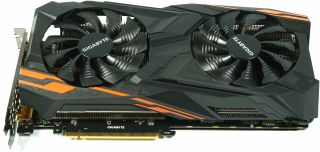
Specifications
Market & Availability
According to our sources, AMD's board partners have only received a few thousand Vega 10 GPUs, and most of those are destined for RX Vega 64 cards. Thus, a general shortage of packages is preventing anyone from mass-producing notable quantities of either model. It's simply not possible to start and stop a production line over and over again. It costs too much time and money.
We were lucky to get our hands on a sample of Gigabyte's Radeon RX Vega 56 Gaming OC 8G, since we heard that fewer than 100 made their way into Germany. Buying a card of our own was the only way to get one into into the German lab. Here in the U.S., this is a mythical creature. Nobody has it for sale, and the only references online come from Gigabyte's site or product announcement news stories.
Unboxing, Look & Feel
Weighing just over 1kg, Gigabyte's card is an astonishing 600 grams lighter than Sapphire's Radeon RX Vega 64 Nitro+. This implementation is also considerably more compact, yielding a length of just 27.8cm, a height measurement of 13cm, and 4.7cm of width.
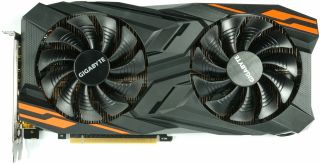
Two counter-rotating fans, each with a diameter of 9.5cm, are positioned inside 10cm openings. According to Gigabyte, its unique fan blade design splits airflow and guides it through curves on the fan surface, improving flow compared to traditional fans. Naturally, we'll test the efficacy of those claims shortly.
The backplate doesn't feature an Aorus logo, which was present on a pre-production model we briefly had our hands on. A copper insert placed on the back of the package is thermally isolated from this plate. Both components do play a role in cooling, though. Not pictured is a heat pipe that snakes around under the backplate, though we'll cover that in more depth, too.
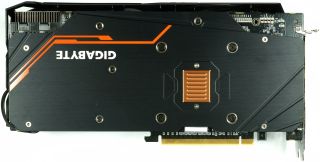
Plan for an extra 5mm of clearance (at least) behind the Radeon RX Vega 56 Gaming OC 8G. This may cause problems on some motherboards, particularly if the heat sink/back plate intrude on an occupied expansion slot or large CPU cooler.
A peek in from the bottom shows that Gigabyte optimized the shape of its vertically-oriented fins. The slight tilt and wave shape are meant to create more efficient airflow, and thus improve cooling.

Up top, it's apparent that Gigabyte paid close attention to cost. There are no RGB lighting effects or other gimmicks. Instead, you get simple injection-molded plastic and printed orange-colored highlights. The white Gigabyte logo is simply printed on. And similar to AMD's reference design, Gigabyte only requires a pair of eight-pin auxiliary power connectors.

The closed back side doesn't reveal much. We catch a mere glimpse of two 8mm and three 6mm heat pipes, along with the fans' cable. On the board itself, we see solder pads for additional components (RGB output, perhaps?) that were obviously abandoned at some point during development.

The I/O bracket is interesting because it features six connectors, rather than the reference design's five. Three HDMI 2.0 ports and three DisplayPort 1.4 outputs are available simultaneously, allowing you to connect six monitors in an Eyefinity array.
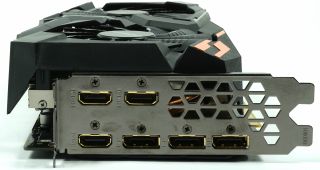
In accordance with AMD's guidelines for clock rates, Gigabyte increased the Radeon RX Vega 56 Gaming OC 8G's base and Boost frequencies significantly. The company also upped its card's power limit by 55W.
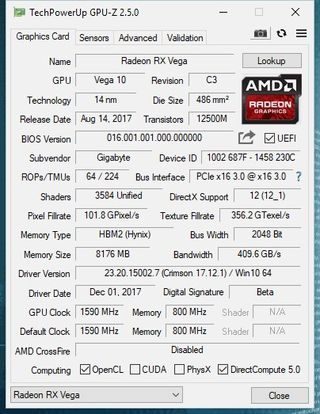
In comparison to the relevant reference cards, the specs read as follows (the GeForce GTX 1070 is deliberately not used for comparison, since in many cases it's dramatically outperformed by an overclocked Radeon RX Vega 56):
| Model | Radeon RX Vega 64 | Gigabyte RX Vega 56 Gaming OC | Radeon RX Vega 56 Reference | GeForce GTX 1070 Ti | GeForce GTX 1080 |
|---|---|---|---|---|---|
| GPU | Vega 10 | Vega 10 | Vega 10 | GP104 | GP104 |
| Die Size | 486 mm² | 486 mm² | 486 mm² | 314 mm² | 314 mm² |
| Transistors | 12.5 billion | 12.5 billion | 12.5 billion | 7.2 billion | 7.2 billion |
| Base/Boost Clock Rate | 1247/1546 MHz | 1275/1590 MHz | 1156/1471 MHz | 1607/1683 MHz | 1607/1733 MHz |
| Shaders/SIMDs | 4096/64 | 3584/56 | 3584/56 | 2432/19 | 2560/20 |
| Texture Units/ROPS | 256/64 | 224/64 | 224/64 | 152/64 | 160/64 |
| Pixel Fill Rate | 79.8 GPix/s | 81.6 GPix/s | 74 GPix/s | 102.8 GPix/s | 102.8 GPix/s |
| Texture Fill Rate | 319.2 GT/s | 285.6 GT/s | 258.9 GT/s | 244 GT/s | 257.1 GT/s |
| Memory Interface | 2048-bit | 2048-bit | 2048-bit | 256-bit | 256-bit |
| Memory Type | HBM2 | HBM2 | HBM2 | GDDR5 | GDDR5X |
| Memory Bandwidth | 484 GB/s | 410 GB/s | 410 GB/s | 256 GB/s | 320 GB/s |
| Memory Speed | 1.89 Gb/s | 1.6 Gb/s | 1.6 Gb/s | 8 Gb/s | 10 Gb/s |
| Memory Size | 8GB | 8GB | 8GB | 8GB | 8GB |
| DX12 Feature Level | 12_1 | 12_1 | 12_1 | 12_1 | 12_1 |
| PCIe Power Connectors | 2x 8-Pin | 2x 8-Pin | 2x 8-Pin | 1x 8-Pin | 1x 8-Pin |
| TDP | 295W | 265W | 210W | 180W | 180W |
Test System & Measurement Methods
We introduced our new test system and methodology in How We Test Graphics Cards. If you'd like more detail about our general approach, check that piece out. We've upgraded the CPU and the cooling system since then to make sure that nothing's holding back graphics cards as fast as this one.
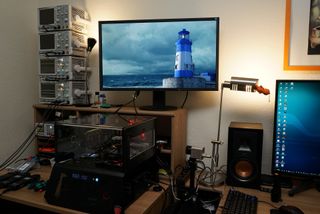
The hardware used in our lab includes:
| Test System | |
|---|---|
| Hardware | Intel Core i7-6900K @ 4.3 GHzMSI X99S XPower Gaming TitaniumCorsair Vengeance DDR4-32001x 1TB Toshiba OCZ RD400 (M.2, System SSD)2x 960GB Toshiba OCZ TR150 (Storage, Images)be quiet Dark Power Pro 11, 850W PSUWindows 10 Pro (All Updates) |
| Cooling | Alphacool Eisblock XPX5x be quiet! Silent Wings 3 PWM (Closed Case Simulation)Thermal Grizzly Kryonaut (Used when Switching Coolers) |
| PC Case | Lian Li PC-T70 with Extension Kit and ModsConfigurations: Open Benchtable, Closed Case |
| Monitor | Eizo EV3237-BK |
| Power Consumption Measurement | Contact-free DC Measurement at PCIe Slot (Using a Riser Card)Contact-free DC Measurement at External Auxiliary Power Supply CableDirect Voltage Measurement at Power Supply2 x Rohde & Schwarz HMO 3054, 500 MHz Digital Multi-Channel Oscilloscope with Storage Function4 x Rohde & Schwarz HZO50 Current Probe (1mA - 30A, 100 kHz, DC)4 x Rohde & Schwarz HZ355 (10:1 Probes, 500 MHz) 1 x Rohde & Schwarz HMC 8012 Digital Multimeter with Storage Function |
| Thermal Measurement | 1 x Optris PI640 80 Hz Infrared Camera + PI Connect Real-Time Infrared Monitoring and Recording |
| Noise Measurement | NTI Audio M2211 (with Calibration File, Low Cut at 50Hz) Steinberg UR12 (with Phantom Power for Microphones) Creative X7, Smaart v.7 Custom-Made Proprietary Measurement Chamber, 3.5 x 1.8 x 2.2m (L x D x H) Perpendicular to Center of Noise Source(s), Measurement Distance of 50cm Noise Level in dB(A) (Slow), Real-time Frequency Analyzer (RTA) Graphical Frequency Spectrum of Noise |
MORE: Best Graphics Cards
MORE: Desktop GPU Performance Hierarchy Table
MORE: All Graphics Content
-
marcelo_vidal With the pricey from those gpus :) I will get an 2400g and play 720P. maybe with a little tweaking I can boost to 1920x1080Reply -
Sakkura This thing about board partners only getting a few thousand Vega 10 GPUs goes back many months now. Has AMD just not been making any more? What the heck is going on?Reply
Seems like Gigabyte did a really nice job making an affordable yet effective cooling solution for Vega 56, it's really a shame it goes to waste because there just aren't any chips available. -
CaptainTom To those complaining about the low supply (and resulting high prices) of AIB cards:Reply
It's because the reference cards are still selling very well (at least for their supply). If vendors can sell the $500 Vega 64 for $600 and sell out, why would they bother wasting time on any other model? -
g-unit1111 Reply20576533 said:To those complaining about the low supply (and resulting high prices) of AIB cards:
It's because the reference cards are still selling very well (at least for their supply). If vendors can sell the $500 Vega 64 for $600 and sell out, why would they bother wasting time on any other model?
That's because miners are the ones buying the cards as fast as they come in stock. It's us gamers and enthusiasts that are waiting for the high performance models. Bad thing is, we don't matter to the bottom line. All they see and want is our precious money, and they don't care what model they sell to us. -
aelazadne Because, the Vendor's making money doesn't equal AMD making money. AMD is losing market share in the GPU scene. With Vega unable to keep up with demand AMD is losing customers who would have bought Radeon's but instead go with Nvidia due to availability. The lack of Availability stemming from August and the fact that even now in early 2018 the Vegas are over priced and hard to find ruins customer confidence. In fact, this situation is so bad that the only people benefitting are the people gouging both Nvidia cards and Radeon cars because at this point there is NO COMPETITION.Reply
Also, just because you are gouging doesn't mean you are making money. AMD has to make money and they need to sell these things in a certain volume. In their contracts with Vendors, they will require their vendors to sell a certain amount of vegas in order to order more. Due to scarcity the only companies making money are Retailers. AMD is going to have to address this issue otherwise their investors will begin to come after them for bungling so bad that their market share dropped so bag. Literally, the intel screw up plus Ryzen being good has been a godsend for AMD, they do not need a declining GPU market share sparking a debate with investors over whether AMD should get out and play the Intel game. -
bit_user Reply
I really appreciate the thorough review.20575687 said:...
The super-imposed heatpipes vs. GPU picture was a very nice touch. For any of you who missed it, check out page 6 (Cooling & Noise) about 1/3 or 1/2 of the way down.
-
bit_user Reply
I think you're too cynical. It's an ASIC supply problem. The AIB partners would probably spend the time if they could get enough GPUs to sell custom boards in enough volume to offset the overhead of doing the extra design work.20576533 said:It's because the reference cards are still selling very well (at least for their supply). If vendors can sell the $500 Vega 64 for $600 and sell out, why would they bother wasting time on any other model?
The only real way out of this is for AMD to design a more cost-effective chip with the graphics units removed. That will divert miners' interest away from their graphics products. -
bit_user Almost as surprising to me as how much more oomph they got out of Vega 56 is how well the stock Vega 64 is holding up against stock GTX 1080. Is it just me, or did AMD really gain some ground since launch?Reply
